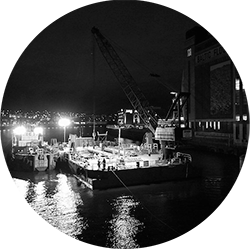Night Shift Work Profile

OTHERS – PROBABLE CARCINOGEN (IARC 2A)
IARC Monograph Vol. 124, 2019 (Group 2A), in prep.
Night Shift Work Profile
QUICK SUMMARY
- Work time organized to cover more than the usual 8-hour workday, up to a 24-hour period
- Associated cancers: Limited evidence for breast, colorectal, and prostate cancer
- Occupational exposures: Approx. 1.8 million Canadians work shifts that fall between midnight and 5am, primarily in trades, health care and social assistance, manufacturing, and accommodation and food services
- Fast fact: Night shift work disrupts the internal biological clock (circadian rhythm). It suppresses melatonin production, disrupts sleep patterns and food digestion, and de-regulates genes involved in cancer pathways.
General Information
Shift work can be defined as the organization of working time by different teams in succession to cover more than the usual eight hour work day, up to a 24 hour period.[1] Some people work shifts on rotation while others perform regularly scheduled day, evening, or night shifts.[1]
Shift work outside of regular daytime hours results in a mismatch between the body’s circadian rhythms and the solar light-dark cycle.[2] Circadian rhythms generate the sleep-wake cycle in humans,[3] acting as an internal biological ‘clock’.[1] Circadian rhythms are synchronized with environmental factors, particularly the 24-hour solar light-dark cycle.[2,4] Night shift work has been found to be the most disruptive to internal circadian rhythms.[1] Circadian disruption is known to suppress melatonin levels, de-synchronize rhythmic body processes (i.e. sleep patterns and food digestion), and de-regulate genes involved in cancer pathways.[1,5]
The International Agency for Research on Cancer (IARC) has classified night shift work as Group 2A, probably carcinogenic to humans, based on sufficient evidence of cancer in animals and limited evidence in humans.[6] In several well-designed animal studies, alteration of rodents’ light-dark schedules (e.g. exposure to repeated 8 hour time shifts in the light-dark schedule, or exposure to a stable 12 hour light and 12 hour dark schedule) lead to increased rates of cancer or tumours [6]. Epidemiological studies observed an increased risk of breast cancer among those working high-intensity shifts over long durations compared to those who do not work at night. However, findings were inconsistent across studies. Some studies considered in the IARC review suggest that prostate and colorectal cancer may also be associated with night shift work.[6] The findings from the epidemiological studies are somewhat limited by factors such as potential confounding and inconsistent definitions of shift work.[6] The Group 2A classification was further supported by strong mechanistic evidence that alteration of light-dark schedule among rodents leads to immunosuppression, chronic inflammation, and cell proliferation, all of which may contribute to cancer growth[6].
In addition to potentially carcinogenic outcomes, night shift work has been associated with changes in mental and physical performance at work, as well as fatigue, stress, disruption to family and social life, depression, and anxiety.[1,7,8] Digestive disorders such as indigestion, heartburn, nausea and loss of appetite, and cardiovascular disorders such as hypertension have been observed in night shift workers.[9] Night shift work has also been linked to reproductive health problems in women and aggravation of previous health conditions such as asthma, diabetes, and epilepsy.[8]
Regulations and Guidelines
No occupational exposure limits for night shift work were located for Canada. In Europe, EU Council Directives ensure that member states take measures concerning night shift length, average working times (daily and weekly), and rest periods (daily and weekly).[5] The International Labour Organization has also issued recommendations around night work frequency, shift length, and rest periods.[5] Both of the above pay special attention to pregnant and young workers.
Night Shift Work in Canada
CAREX Canada estimates that approximately 1.8 million Canadians work shifts between midnight and 5am. This represents around 12% of working Canadians. Industries with the most workers working at night include trades, health care and social assistance, manufacturing, and accommodation and food services.
According to the Burden of Occupational Cancer in Canada project, night shift work leads to approximately 470 to 1,200 suspected breast cancers in women each year, based on past exposures (1961-2001).[10,11,12] This amounts to 2 to 5% of all female breast cancers diagnosed annually. These results are shown as a range because research studies are not in agreement on the impact of night shift work on breast cancer risk. Most occupational breast cancers in women associated with night shift work occur among workers in the health care. These cancers also occur among workers in the accommodation and food services, trade, and manufacturing sectors.
For detailed estimates of exposure to night shift work, see the occupational exposures tab.
Sources
Photo: Wikimedia Commons, Andrew Curtis
Other Resources
- Ontario Institute for Work and Health. Shift work and health (2012)
Subscribe to our newsletters
The CAREX Canada team offers two regular newsletters: the biannual e-Bulletin summarizing information on upcoming webinars, new publications, and updates to estimates and tools; and the monthly Carcinogens in the News, a digest of media articles, government reports, and academic literature related to the carcinogens we’ve classified as important for surveillance in Canada. Sign up for one or both of these newsletters below.
CAREX Canada
School of Population and Public Health
University of British Columbia
Vancouver Campus
370A - 2206 East Mall
Vancouver, BC V6T 1Z3
CANADA
As a national organization, our work extends across borders into many Indigenous lands throughout Canada. We gratefully acknowledge that our host institution, the University of British Columbia Point Grey campus, is located on the traditional, ancestral, and unceded territories of the xʷməθkʷəy̓əm (Musqueam) people.


